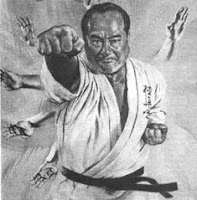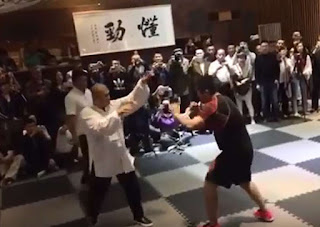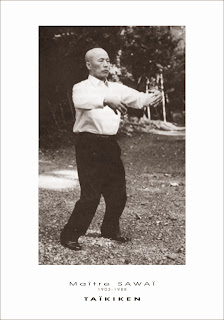Why "corkscrew" your punch?
In my view the reason so many martial arts utilise the standard "corkscrew punch" (eg. karate, taekwondo, many shaolin schools, etc.) has little to do with a conscious effort at enhancement of power/stability, or because of fashion or aesthics.
It is simply a function of our biomechanical design.
 Consider a very short, close range punch into the ribs - with an uppercut type action. Your palm will naturally face upward.
Consider a very short, close range punch into the ribs - with an uppercut type action. Your palm will naturally face upward.Think of a handshake where you are middle distance (ie. your elbow is not fully extended). Your palm is side on and you have what is known as "vertical fist" punch.
Now think of an extended "raise your arms in front" (as a doctor or physiotherapist might ask you to do) - or even a pointing action - ie. where your elbow is fully extended. The most natural position is palm down. Hence when you have a fully extended punch it will naturally end up with the full corkscrew.
The standard "karate-type" punch covers all three of the above "stages"; at the beginning of the punch the palm is facing up. As the elbow clears the body the palm starts to turn to vertical fist. At its absolute maximum range it is turned over fully. Most of the turn from vertical happens in the very last few centimetres (or last inch or so for you Americans).
We practise a "full" movement when we practise basics. However when you hit, chances are you will not be landing a fully extended punch, hence it will be something in the spectrum of what is essentially a natural way of extending a hip chambered hand.
And yes - it does "add power" and "add stability" to do it this way, provided you are turning over the punch at the correct stage of your extension. Why? Because you are moving in a biomechanically efficient manner. Conversely, moving in an inefficient manner will reduce your power.
For example, it won't help you one iota to corkscrew your punch too early (ie. a short punch with a full corkscrew); rather it will be detrimental (the old "rabbit punch" is not something one associates with a trained fighter).
Now try doing a fully extended punch without turning your fist over at all (ie. palm up all the way).
Both of the above examples are seriously dorky.
Most punches we land are mid-range (in what I call the centre of the "melee") hence they will be vertical fist or slightly turned over from there. A full basic punch should cover all the stages as part of learning a natural movement.
It is important to note that a fully extended vertical fist punch isn't too bad (there won't be much difference in measurable power), but it still isn't as natural as a palm down. I emphasise "fully extended" because it really should be the last inch or so that most of your turn occurs.
That turning action at the end also grinds your knuckles in causing more damage - an added bonus.
It is also important to note that my comments above apply only in relation to the standard karate-type "corkscrew" punch.
There are other ways of punching utilising different principles.
For example you will note that I "bend the rules" in the video below (albeit using an open hand strike - but it could easily be turned into a punch at the last second):
I demonstrate suri ashi a type of sliding foot action together with an open palm strike
Much depends on how you load your strike/punch (or, rather, your “start position”). If you are using a high chamber, for example, there will be no "corkscrew" action at all.
I demonstrate the "kosa zuki" or cross as done in karate
Copyright © 2008 Dejan Djurdjevic



Readingthis, I am reminded of that "perfect pushup" product with the handles on circular ball-bearing tracks that rotate during the pushup.
ReplyDeleteI like and agree with your 'natural arc' explanation whilst raising the chambered fist. But I'd like to comment about the increased power as briefly mentioned in your video. A right cross as performed with hand raised generates more power, but only from the perspective of the striking limb; it uses the shoulder muscles and upper body mass more effectively. However, a chambered centreline upper level punch together with a lunging type move will create as much or if not more power but does this using the entire body accelerating to the target. We perform our chambered punches slightly differently, preferring to shoot it closer to the centreline - it's a strategically sound tactic as opposed to a punch coming more from the side.
ReplyDeleteThe funny thing is, I kind of figured this out through experiment and by watching Wing Chun videos, stories from karateka, and full body weight strikes.
ReplyDeleteMy wrist just plain hurt if I tried to hold it to my side with the palm down. The structure just felt wrong. It always did, but it wasn't until I used full momentum that it felt like it would break. Then I experimented with the various fist alignments and everything became clear there.
I think if I had read this first, I wouldn't have had to go through that period.
I researched the biomechanics of certain actions. While you state that a corkscrew punch does add power and stability, you don't provide support for that statement. There is a professor at a US university that wrote an article on this issue, and his conclusion was that a 3/4 twist fist is the best punch anatomically speaking to deliver and absorb the force of a punch. There is no study that I've seen that demonstrates the increased efficacy of a corkscrew punch.
ReplyDeleteYou refer to power, presumably in the mechanical sense. Ask yourself this, why do you want power? Many books are written attempting to explain martial art technique in mechanical terms, but, they do not reconcile the mechanical terms with effect. I attempted to do so and stumbled across an amazing body of knowledge that does so.
Ask yourself this: what causes an injury? Rather than looking at it from the practitioners point of view, look at it from the receipients point of view, and then, and only then, does any mechanical explanation contribute to our knowledge and understanding of these techniques.
"I researched the biomechanics of certain actions. While you state that a corkscrew punch does add power and stability, you don't provide support for that statement."
ReplyDeleteTrue, I haven't provided support for this statement. It seems to me that the rifling/corkscrew action is conducive to stability particularly as the arm moves from one natural position to another, in the natural extension of the arm. Try to punch with your palm up the whole way and you'll see how unstable that is. Try with your palm down and ditto - same thing.
I might have no real support for this proposition, but it makes intuitive sense to me! And this is, after all, a blog - not an exhaustive scientific paper!
"There is a professor at a US university that wrote an article on this issue, and his conclusion was that a 3/4 twist fist is the best punch anatomically speaking to deliver and absorb the force of a punch. There is no study that I've seen that demonstrates the increased efficacy of a corkscrew punch."
The may be so. But are we talking at impact? Because the fist, in my version, would probably be at 3/4 twist at impact. I'm willing to be persuaded otherwise anyway - I'm not wedded to any position. I'm merely elucidating my own experience here. I am aware that plenty of folks disagree with me!
"You refer to power, presumably in the mechanical sense. Ask yourself this, why do you want power?"
I don't really refer to "power". I'm more concerned with force applied over a short period (impulse).
"Many books are written attempting to explain martial art technique in mechanical terms, but, they do not reconcile the mechanical terms with effect. I attempted to do so and stumbled across an amazing body of knowledge that does so."
I would love to hear more!
"Ask yourself this: what causes an injury? Rather than looking at it from the practitioners point of view, look at it from the receipients point of view, and then, and only then, does any mechanical explanation contribute to our knowledge and understanding of these techniques."
I thought I had examined it from that perspective. It seems to me applied force (force applied to the target - and applied in a way that causes deformation of the target) is in issue. Other issues such as pressure (the size of the striking surface and the nature of the target surface) are instrumental, but tangential to the basic issue of comparing, say, punches to the body with punches to the body.
Thanks again for your insightful and thought-provoking remarks.
I can't confirm this from personal experience, but I've heard that in a full force corkscrew punch, its possible for your knuckles to actually tear the flesh and muscle tissue if you twist on impact. Any thoughts?
ReplyDeleteSkin is "cut" by boxing gloves, so I can't see why knuckles couldn't do it during a corkscrew motion. However I don't think this is a primary reason for punching this way. Thanks for your comment!
ReplyDelete